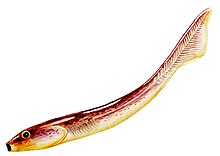Palaeospondylus
| Palaeospondylus Temporal range:
| |
|---|---|

| |
| Scientific classification | |
| Kingdom: | |
| Phylum: | |
| Subphylum: | |
| Genus: | Palaeospondylus
|
Palaeospondylus gunni ("Gunn's Ancient Vertebrae") is a mysterious, fish-like fossil vertebrate. Its fossils are described from Achannaras slate quarry in Caithness, Scotland.
The fossil as preserved is carbonized, and indicates an eel-shaped animal of up to 6 centimetres (2 in) in length. The skull, which must have consisted of hardened cartilage, exhibits pairs of nasal and auditory capsules, with a gill-apparatus below its hinder part, but no indications of ordinary jaws.
The phylogeny of this bizarre fossil has puzzled scientists since its discovery in 1890, and many taxonomies have been suggested. In 2004, researchers proposed that Palaeospondylus was a larval lungfish[1]. Previously it had been classified as a larval tetrapod, unarmored placoderm, an agnathan, and a chimaera.[2]
See also
References
- ^ Thomson, K.S. 2004. A Palaeontological Puzzle Solved?. American Scientist 92:209
- ^ Palmer, D., ed. (1999). The Marshall Illustrated Encyclopedia of Dinosaurs and Prehistoric Animals. London: Marshall Editions. p. 33. ISBN 1-84028-152-9.
This article incorporates text from a publication now in the public domain: Chisholm, Hugh, ed. (1911). Encyclopædia Britannica (11th ed.). Cambridge University Press. {{cite encyclopedia}}: Missing or empty |title= (help)
